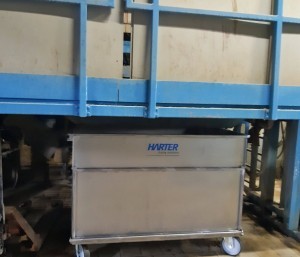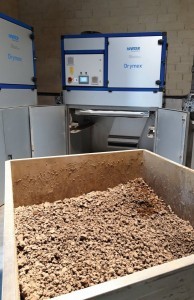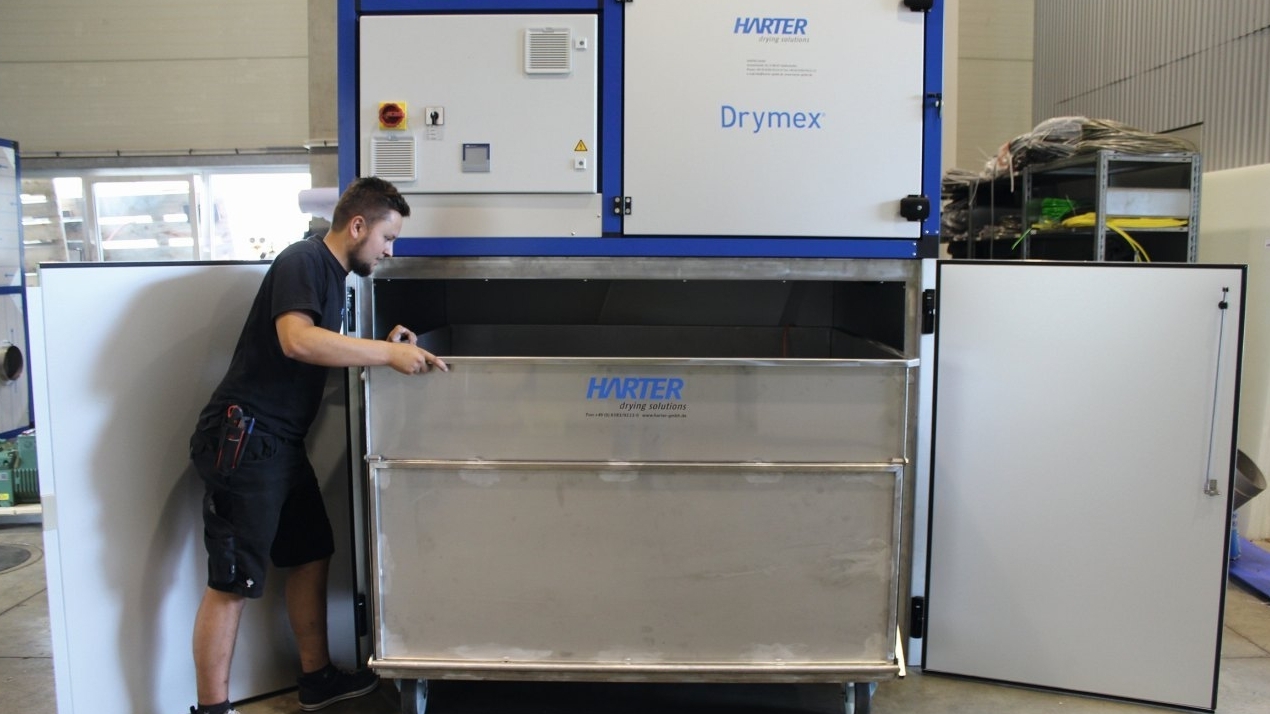A company from Poland is looking for suitable drying technology to reduce its operating costs. The solution is an energy-saving heat pump technology from the Allgäu region.
The container filled with sludge is fed into the dryer and dried to the desired residual moisture at approx. 50 °C for 24 hours
 The sludge pre-dewatered in the chamber filter press is drained into the container below The innovative electroplating company Protech Sp. z o.o. from Rypin in Poland is a pioneer in its region, as this is the first time a German technology has been used to reduce disposal costs. Waste water sludge is produced during the production process in the electroplating shop. This is mechanically pre-dewatered using a chamber filter press and was previously sent to landfill. At this point, however, the sludge still has a water content of around 70%. This means that the operator pays the majority of his disposal costs for water alone. Drying can reduce the weight and volume by up to 60 %, depending on the sludge. This also means a 60% reduction in disposal costs. If the landfill prices are correspondingly high, drying the sludge becomes a financially interesting calculation. This is made even more interesting by the use of particularly energy-saving drying technology.
The sludge pre-dewatered in the chamber filter press is drained into the container below The innovative electroplating company Protech Sp. z o.o. from Rypin in Poland is a pioneer in its region, as this is the first time a German technology has been used to reduce disposal costs. Waste water sludge is produced during the production process in the electroplating shop. This is mechanically pre-dewatered using a chamber filter press and was previously sent to landfill. At this point, however, the sludge still has a water content of around 70%. This means that the operator pays the majority of his disposal costs for water alone. Drying can reduce the weight and volume by up to 60 %, depending on the sludge. This also means a 60% reduction in disposal costs. If the landfill prices are correspondingly high, drying the sludge becomes a financially interesting calculation. This is made even more interesting by the use of particularly energy-saving drying technology.
At the annual meeting of the Polish Surface Association PTG, Protech came into contact with the drying plant manufacturer Harter from Stiefenhofen in the Allgäu region via the Polish representative Jeremi Rogalewski. The company developed condensation drying with heat pump technology 30 years ago and uses it for a wide range of applications. The drying of pre-dewatered sludge is its oldest mainstay. Protech accepted Harter's offer and ordered a rental system to carry out its own tests with its sludge. The large electroplating company had already carried out such tests with conventional sludge dryers.
High water extraction saves weight and money
However, Bartosz Bekter, plant manager at Protech, was not satisfied with the results. Too much manpower, too much dust, too much exhaust air. At the Harter dryer, they were amazed to discover on site that not only could the weight and volume of the sludge be reduced by around 60%, but that handling was also very simple. "It was this push-in, switch-on, ready experience that completely won us over," says Bekter. The economic analysis also showed a good payback period with an ROI of 2.4 years. The savings in disposal and transportation costs are 60%. Protech therefore invested in two sludge dryers.
These are two standard Drymex® M5 dryers, each with two drying containers. The containers each have a useful volume of 1.5m3. The procedure today is as follows: after pressing in a chamber filter press, the sludge is emptied into one of the two drying containers and transported to the sludge dryer by forklift truck and driven in. The doors of the compact system are closed and the drying process is started. Meanwhile, the second container is located under the chamber filter press for the next emptying. Protech produces approx. 3 tons of sludge with a dry matter content of 25% per working day. After approx. 20-24 hours of drying, this is approx. 85 %. The water removal capacity of the M5 dryers is approx. 800 l / 24 h.
0.4 kWh is required for 1 liter of water extraction. Once the set desired degree of dry air has been reached, the system switches off automatically via a humidity measurement. For subsequent emptying, the containers are equipped with a tipping device, with the help of which the dried sludge is simply and completely emptied into a transport container and then sent for disposal. The nominal output of an M5 sludge dryer is 13.3 kW.
Completely free of exhaust air
 Drying significantly reduces the volume, weight and, above all, the disposal costs of the sludge Condensation drying with heat pump technology works with extremely dry air in an energetically closed circuit: The heart of all drying systems is a dehumidification unit in which air is heavily dehumidified and heated. This now extremely dry and therefore unsaturated air is fed via an air duct system into the drying container in which the sludge to be dried is located. Due to the low relative humidity in the circulating air, the air now absorbs the moisture from the filter cake. The drying process begins. The now moist air is fed back into the dehumidification unit and cooled down. The water condenses and leaves the system. The dry air is then reheated and fed back into the container. The air circuit is closed. This system from Harter is demonstrably the only one on the market that can operate completely free of exhaust air. However, even the driest air is worth nothing if it does not reach where it is supposed to absorb the moisture. The right air flow plays a key role in any type of drying process. In the case of sludge drying, it must be implemented in such a way that the unsaturated air can flow evenly through all areas of the filter cake. For this purpose, the drying containers are equipped with a specially developed aeration floor and individual air control technology. The combination of air dehumidification and air guidance makes it possible to aerate larger bulk heights homogeneously and thus dry the sludge evenly and completely. The temperatures are usually between 40 and 50 °C.
Drying significantly reduces the volume, weight and, above all, the disposal costs of the sludge Condensation drying with heat pump technology works with extremely dry air in an energetically closed circuit: The heart of all drying systems is a dehumidification unit in which air is heavily dehumidified and heated. This now extremely dry and therefore unsaturated air is fed via an air duct system into the drying container in which the sludge to be dried is located. Due to the low relative humidity in the circulating air, the air now absorbs the moisture from the filter cake. The drying process begins. The now moist air is fed back into the dehumidification unit and cooled down. The water condenses and leaves the system. The dry air is then reheated and fed back into the container. The air circuit is closed. This system from Harter is demonstrably the only one on the market that can operate completely free of exhaust air. However, even the driest air is worth nothing if it does not reach where it is supposed to absorb the moisture. The right air flow plays a key role in any type of drying process. In the case of sludge drying, it must be implemented in such a way that the unsaturated air can flow evenly through all areas of the filter cake. For this purpose, the drying containers are equipped with a specially developed aeration floor and individual air control technology. The combination of air dehumidification and air guidance makes it possible to aerate larger bulk heights homogeneously and thus dry the sludge evenly and completely. The temperatures are usually between 40 and 50 °C.
State subsidies
While governments in Germany, Austria and Switzerland are promoting energy-saving technologies such as Harter's heat pump dryers, Polish companies are still waiting for financial support of this kind. However, a trend is emerging. More and more companies prefer to work with companies that reduce theirCO2 emissions and invest in pioneering technologies. And Protech is setting a very good example here. Bekter sums up with satisfaction: "The high costs of transportation and disposal have been a thorn in our side for some time. Now, with the Harter dryers, we have found a very modern, cost-saving and practical solution."


